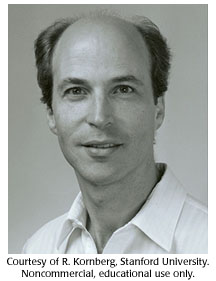Concept 29 DNA is packaged in a chromosome.
 In 1974, Roger Kornberg worked out the importance of histones to chromatin structure.
In 1974, Roger Kornberg worked out the importance of histones to chromatin structure.
Roger Kornberg (1947-)

Roger Kornberg was born in St. Louis, Missouri. He was the first of three children born to Arthur Kornberg and his wife, Sylvy. With both parents being well-respected scientists, it was not surprising that Roger Kornberg also developed an interest and an enthusiasm for science. As he said in an interview:
Science was a part of dinner conversation and an activity in the afternoons and on weekends. Both my parents had fine scientific minds and taught by example how to approach questions and problems in a logical, dispassionate way. Scientific reasoning became second nature. Above all, the joy of science became evident to my brothers and me.
Kornberg studied chemistry and biochemistry, and without having to think about it, became a scientist. He graduated from Harvard University in 1967 with a Bachelors in science, and went to Stanford University for graduate work. His doctoral thesis was on the chemical nature of phospholipids.
In 1972, Kornberg went to the Medical Research Council in Cambridge for postdoctoral work in X-ray crystallography. There he became interested in the X-ray patterns Aaron Klug obtained for chromatin. Using this and other experimental data, Kornberg eventually worked out the importance of histones to chromatin structure. Kornberg published his results in 1974.
Kornberg stayed on staff at the MRC until 1975 when he was offered an assistant professorship at Harvard University. In 1978, he moved to Stanford University where he is now professor of structural biology.
Over the past 35 years, Kornberg has published over 150 peer-reviewed research papers on phospholipid and chromatin structure, gene regulation and transcription control. His current research interest is on the overall structure of chromatin and chromosomes and how such structuring may be associated with gene repression. In 2006, Kornberg was awarded the Nobel Prize in Chemistry “for his studies of the molecular basis of eukaryotic transcription."
Kornberg used to play the violin as a child and likes to read. However, he admits that his main interest outside of science revolves around his family.


Roger Kornberg's brother, Thomas, is also a scientist. He isolated DNA polymerase III used for replication. Kornberg's other brother is an architect and designs research laboratories.

Why are there eight histones to each nucleosome? Wouldn't it be easier to have one large protein?
 DNA is packaged in a chromosome.
DNA is packaged in a chromosome. Higher cells incorporate an ancient chromosome.
Higher cells incorporate an ancient chromosome. Some DNA does not encode protein.
Some DNA does not encode protein. Some DNA can jump.
Some DNA can jump. Genes can be turned on and off.
Genes can be turned on and off. Genes can be moved between species.
Genes can be moved between species. DNA responds to signals from outside the cell.
DNA responds to signals from outside the cell. Different genes are active in different kinds of cells.
Different genes are active in different kinds of cells. Master genes control basic body plans.
Master genes control basic body plans. Development balances cell growth and death.
Development balances cell growth and death. A genome is an entire set of genes.
A genome is an entire set of genes. Living things share common genes.
Living things share common genes. DNA is only the beginning for understanding the human genome.
DNA is only the beginning for understanding the human genome.